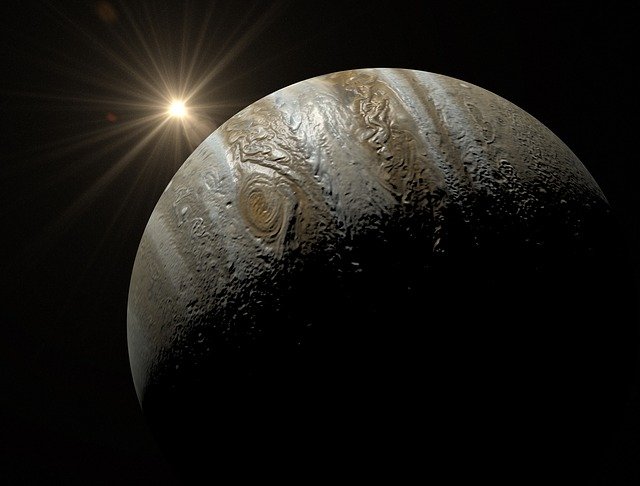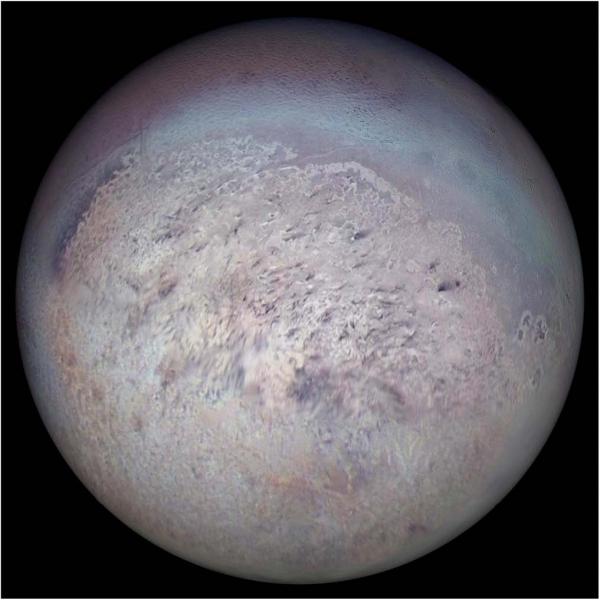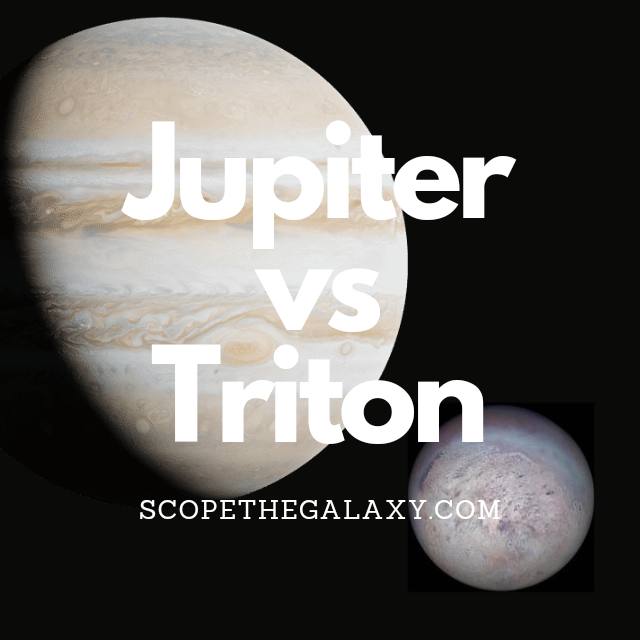*This post may contain affiliate links. This means we may make a commission if you purchase an item using one of our links*
The main differences between Jupiter and Triton are that Jupiter is a gas giant planet with 79 moons whilst Triton is a natural satellite that orbits Neptune, Triton has volcanic activity on its surface whilst Jupiter can’t due to is gas based composition and Jupiter has the strongest magnetosphere in our solar system whilst Trtion has no magnetic field.
There are various other differences between the two so, continue reading for a more detailed look at each of these celestial bodies along with their similarities and differences below.
What Is The Planet Jupiter?
Table of Contents

Jupiter is the 5th farthest planet from the Sun and the largest planet within our local solar system. The planets most recognizable trait is the giant red spot visible on its atmosphere along with the brown horizontal bands flowing across its atmosphere.
As a result of its composition and size, Jupiter falls under the classification of a gas giant.
This is because its composition mostly consists of the elements hydrogen and helium. The split is roughly 71% hydrogen, 27% helium, with the remainder of the elements split throughout the left over 2%.
As the biggest planet in our solar system, Jupiter is 139,820 km or 1,300 Earths in diameter, it has a mass of around 0.001 solar masses, the temperature when inside the clouds are roughly -145 degrees Celsius whilst the core is far hotter, equating in the region of 24,000 degrees Celsius.
Due to its extreme circumstances, gaseous composition and distance from the Sun, the planet is not theoretically capable to support life, from its subzero temperature to the extremely fast 640 km/h winds, and its gravity which may be unsustainable for our bones, roughly 2.4 times greater than Earth’s.
Although the conditions on Jupiter aren’t suitable for us, some of its 79 moons like Europa for example could support life.
This brown giant has a relatively fast rotation around its axis where 1 rotation typically takes 10 hours to make whilst its orbit around the Sun is far longer taking in the region of 12 years for 1 full cycle.
Another feature of Jupiter that is renowned by astronomers is the strength of its magnetic field. In comparison to the other planets in our solar system it is even stronger than our Sun, where it’s over magnetosphere is roughly 20,000 times the strength of Earth.
What this means is that Jupiter’s magnetosphere is able to avert solar winds that are 3 million kilometers away from it.
What Is The Moon Trition?

Triton is the largest moon of Neptune, whose most unusual feature is its retrograde orbit. Triton is the only major moon in our solar system which orbits in the opposite direction of its planet’s rotation.
First discovered on 10th October 1846 (just 17 days after the discovery of its planet, Neptune) by British astronomer William Lassell, “Triton” comes from a merman in Greek myth; a name which perhaps stems from the composition of this faraway moon.
The diameter of Triton is approximately 2,706km, making it a similar size to Earth’s moon. However, we know that its mass is far less than the first estimates suggested because data from Voyager showed that the surface is icy and highly reflective, a less dense composition than the dark surface of our moon.
This icy surface has resulted in ice based natural satellite displaying temperatures in the region of – 235 degrees Celsius.
This lower density stems predominantly from the water-ice interior encasing a denser rock core. Still, the mean density of 2.06 grams per cubic cm remains higher than that of any of Saturn’s or Uranus’ moons. In addition, Triton holds more than 99.5% of the mass of everything that orbits the planet Neptune and its total mass is greater than every smaller satellite in the solar system combined.
Scientists think that Triton may be an object from the Kuiper Belt that Neptune’s gravity captured millions of years ago. This is because it shares many similarities with the dwarf planet Pluto – the best-known world within the Kuiper Belt.
This frozen world is a land of geological oddities with craters and a collection of depressions and ridges known as cantaloupe terrain. The geysers found on this moon shoot plumes of nitrogen as high as 8km high, which creates a thin atmosphere of nitrogen.
In around 3.5 billion years, Triton’s orbit will travel too close to Neptune, and the planet’s gravitational pull will break the moon apart, creating a ring system.
Similarities Between Jupiter And Triton
There are a few similarities that Jupiter and Triton share, which in this case includes the following:
- Both are a spherical shape.
- Both have a hotter core.
- Both are part of the same solar system.
- Neither have tectonic plates.
- Both orbit another object.
Differences Between Jupiter And Triton
As for the differences between the two, they include the below:
- Triton orbits Neptune whilst Jupiter only orbits the Sun.
- Jupiter is a gas giant whilst Triton is a terrestrial based natural satellite.
- Jupiter has 79 moons whilst Triton has 0.
- Jupiter has a diameter of 139,820km whilst Triton’s diameter is 2,706km.
- Triton has a very thin exosphere composed mostly of nitrogen with small amounts of methane whilst Jupiter is gas based, composed mostly of hydrogen and helium.
- A day on Triton takes 5.877 days whilst Jupiter takes 10 hours.
- It takes Triton 5.877 days to orbit Neptune and around the Sun in 165 years whilst Jupiter orbits the Sun in 12 years.
- Jupiter has an axial tilt of 3.13 degrees whilst Triton’s axial tilt is close to 0.
- Triton’s average temperature is around -235 degrees Celsius whilst Jupiter has an average temperature of – 145 degrees Celsius.
- Jupiter’s density is 1.33 g/cm³ whilst Triton’s density is 2.06 g/cm³.
- Jupiter’s mass is 1.898 × 10^27 kg whilst Triton’s mass is 2.14 × 10^22 kg.
- Triton’s gravitational strength is 0.779 m/s² whilst Jupiter is 24.79 m/s².
- Trtion is the only moon in our solar system that orbits its planet in a retrograde orbit whilst Jupiter orbits the Sun.
- Triton is tidally locked to Neptune whilst Jupiter is not tidally locked to any entity.
- Jupiter has the strongest magnetosphere in the entire solar system whilst Triton does not.
Summary
Although Jupiter and Triton are found within the same solar system, the manner is which they are designed and how they function are completely different from one another.
Whether it be in regards to their size, mass, the length of their day, their magnetic field and more so, it isn’t surprising that Jupiter is as different as it is from Triton.

